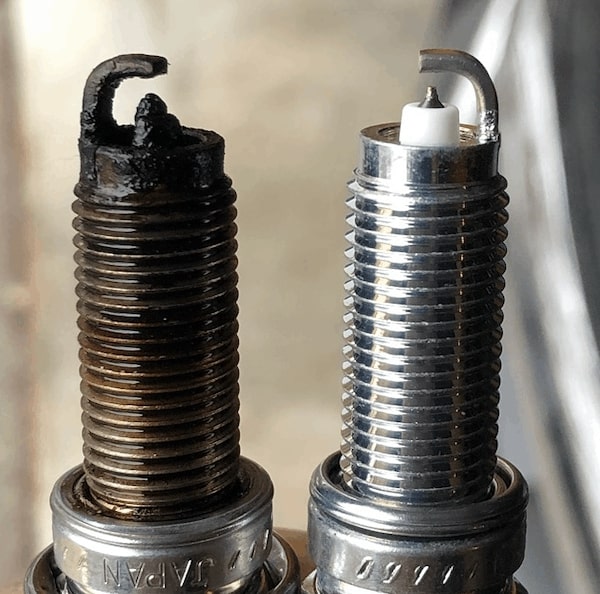Really, there is no perfect answer for when to change spark plugs. If you have a vehicle made in the last 20 years (like most of us do), they can go 100k miles or more without any noticeable decrease in performance.

The answer is really two parts:
- Is the check engine light on? If you have P0300 (Random Misfire) or P030X (where X = the cylinder misfiring), it’s likely a spark plug-related issue.
- Have your plugs gone past the maintenance window for your vehicle? Going too far can decrease engine efficiency (fuel mileage).
Why Change Spark Plugs When Your Car is Running Fine
Proper maintenance of your vehicle’s spark plugs is crucial for optimal engine performance. These plugs are key components in your car’s ignition system, providing the necessary spark to ignite the air/fuel mixture within the cylinders.
- Timely spark plug replacement prevents common engine problems.
- It ensures reliable starting and smooth engine operation.
- Regular checks can uncover issues like fouling or abnormal wear.
- Keeping spark plugs in good condition can improve fuel efficiency.
- It prevents misfires, which may lead to expensive catalytic converter damage.
Here’s what you can typically expect with well-maintained spark plugs:
- Quicker acceleration: Your vehicle responds better when you hit the gas pedal.
- Consistent combustion: This can lead to fewer emissions and a cleaner-running engine.
Monitor your spark plugs and replace them according to the manufacturer’s recommended interval. This simple step can save you from unexpected breakdowns and maintain your car’s performance.
Identifying When to Change Spark Plugs

Knowing when to replace your spark plugs can keep your vehicle running smoothly and maintain its performance. This section breaks down the specific criteria so you can accurately determine the right time for a change.
Manufacturer Recommendations
- Check your owner’s manual: Your vehicle’s manufacturer provides guidelines on when to replace spark plugs. Typically, this ranges from 30,000 to 100,000 miles, depending on the vehicle.
Mileage Indicators
- Standard copper spark plugs: Usually need replacing after about 30,000 miles.
- Iridium and platinum spark plugs: Can last up to 100,000 miles due to their durability.
Remember, these figures are guidelines. Your actual replacement interval could vary based on driving conditions and other factors.
Performance Issues
- Engine Misfires: Stuttering or a slight jolt when you try to accelerate could suggest spark plug issues.
- Reduced Fuel Economy: Notice a significant drop in your miles per gallon? Worn spark plugs might be to blame.
- Difficulty Starting: If your car struggles to start, it’s worth checking the condition of your spark plugs.
- Rough Idling: A rough, irregular engine noise when your car is stationary can be a symptom of spark plug degradation.
Monitor these signs closely; they could indicate it’s time for a spark plug replacement to ensure your vehicle continues operating at its best.
Changing Spark Plugs: Step-by-Step Guide
Before you begin, make sure your vehicle is turned off, the engine is cool, and you have the necessary tools, which typically include a socket set, spark plug gapper, and spark plug wire puller.
Step 1: Locate the Spark Plugs
- Your spark plugs usually line up with the cylinders.
- They are connected by thick wires.
- You might need to remove the engine cover.
Step 2: Remove the Spark Plug Wires
- Carefully pull on the boot of the wire.
- Do this one at a time to avoid mixing them up.
Step 3: Remove the Old Spark Plugs
- Use a spark plug socket and extension on your ratchet to remove them.
- Turn the socket counterclockwise to loosen.
- Inspect the old spark plugs to gauge engine condition.
Step 4: Check and Adjust the Gap of the New Spark Plugs
- Use a spark plug gapping tool to ensure the correct gap.
- This gap allows for optimal performance.
Step 5: Install the New Spark Plugs
- Hand-tighten the new spark plugs first to avoid cross-threading.
- Finish tightening with the ratchet, but avoid over-tightening.
Step 6: Re-Attach Spark Plug Wires
- Make sure the wire’s boot fits securely over the new plug.
- Confirm the connections are firm and correct.
Remember to work carefully and methodically to avoid damaging your vehicle’s engine components. Properly maintaining your spark plugs can lead to better fuel efficiency and engine performance.
Frequency Factors Affecting Spark Plugs
Several factors impact how frequently you should replace your spark plugs. Pay close attention to these to keep your vehicle running smoothly.
Engine Type
- Conventional Engines: Typically require spark plug replacement every 30,000 to 50,000 miles.
- High-Performance Engines: May need more frequent changes, as often as every 20,000 miles, due to higher heat and pressure conditions.
Driving Conditions
- City Driving: Frequent stopping and starting can lead to spark plug wear, necessitating changes every 30,000 miles.
- Highway Driving: Less frequent changes may be needed, often beyond 50,000 miles, as constant speeds cause less wear.
Spark Plug Type
- Copper Spark Plugs: Generally have the shortest life span, ranging from 20,000 to 40,000 miles.
- Iridium and Platinum Spark Plugs:
- Iridium: Can last up to 60,000 to 150,000 miles.
- Platinum: Typically need to be changed every 60,000 to 100,000 miles.
Troubleshooting Common Spark Plug Problems
When your vehicle exhibits performance issues, faulty spark plugs may be to blame. Knowing how to identify and resolve common spark plug problems can save you time and money. Here are some tips to help you troubleshoot effectively:
- Engine Misfires: If you notice your engine misfiring, it could signal a problem with a spark plug. Check for:
- Worn electrodes
- Damaged insulators
- Deposits or fouling
- Rough Idling: Your car should run smoothly. Rough idling can point to spark plugs that are:
- Out of gap specification
- Contaminated with oil or fuel
- Cracked or chipped
- Trouble Starting: Difficulty in starting your car might be due to spark plugs that are:
- Wet with fuel
- Covered in carbon deposits
- Experiencing a weak spark
- Decreased Fuel Economy: If your fuel consumption is higher, faulty spark plugs might be failing to ignite the fuel efficiently. Inspect for:
- Incorrect spark plug gap
- Worn spark plug tips
- Oil or ash on the plug’s surface
For each of these issues, your first step is to visually inspect the spark plugs. Remove them using a spark plug socket, ensuring not to apply too much force.
Look for obvious signs of damage or wear. Use a gap tool to check and adjust the plug gap to your vehicle’s specifications. If plugs are damaged or excessively worn, replace them. Always follow torque recommendations to avoid damaging the spark plug or cylinder head.
Remember to consult your vehicle’s manual or a professional for specifications unique to your make and model. Regular maintenance is key to avoiding spark plug problems and ensuring your vehicle runs efficiently.




